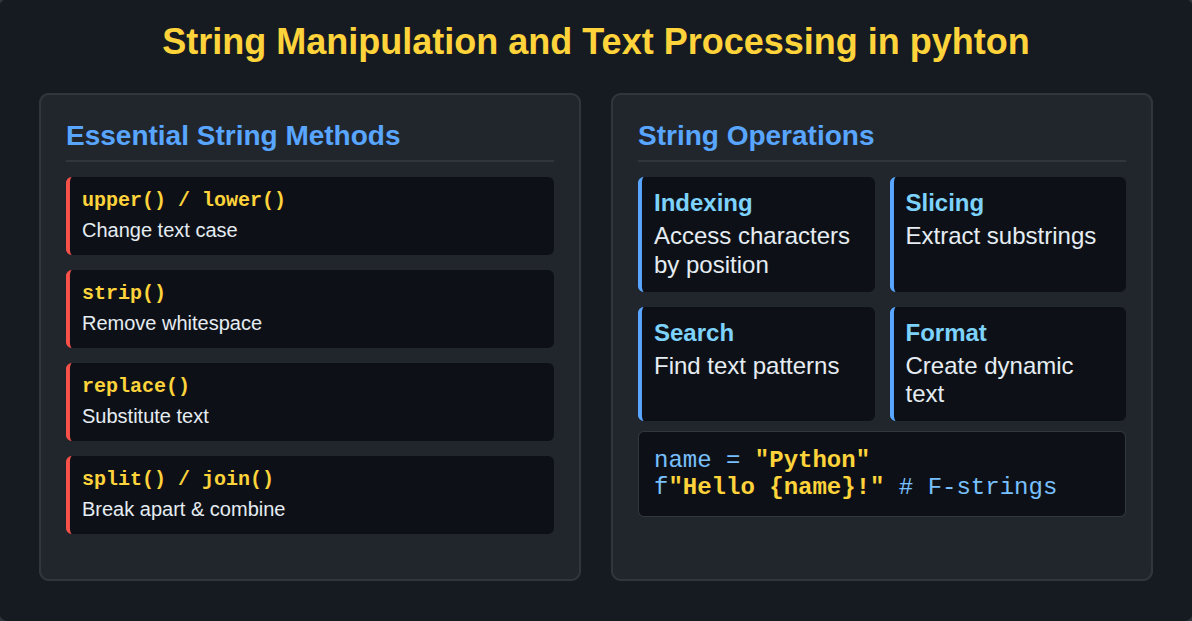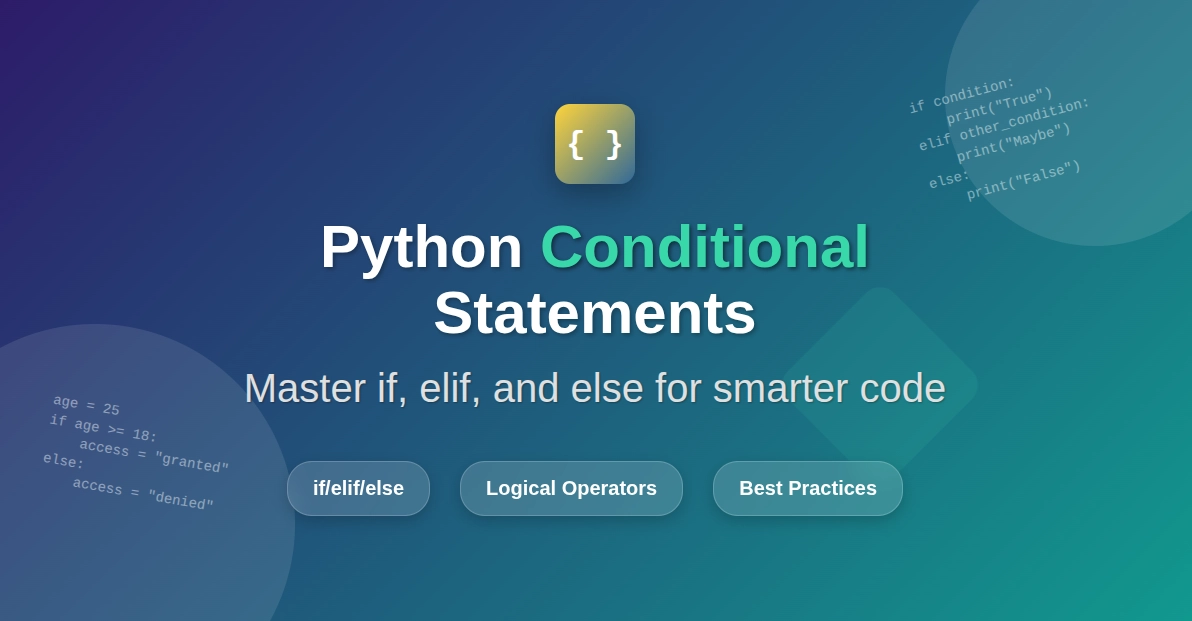What is String Manipulation in Python?
String manipulation in Python involves modifying, analyzing, or processing string data types. A Python string is an ordered, immutable sequence of characters enclosed in single quotes (' '), double quotes (" "), or triple quotes (""" """). For example, "hello world" is a string.
You’ll use string manipulation in many areas:
- Data Cleaning: You can remove unwanted spaces or characters from text data.
- Text Processing: You can extract information from log files or user input.
- Web Development: You can build dynamic web pages by formatting text.
- Data Analysis: You can prepare text for analysis by converting cases or splitting sentences.
Mastering string manipulation helps you handle text efficiently. This makes your code more robust and adaptable.
In this course, you will learn the fundamentals of Python: from basic syntax to mastering data structures, loops, and functions. You will also explore OOP concepts and objects to build robust programs.
6 Steps to Master String Manipulation in Python
Here are 6 steps to effectively manipulate strings in Python.
Step 1: Create and Access Strings
You need to create strings before you can manipulate them. You also need to know how to access individual characters or parts of a string.
How to Create Strings
Python lets you create strings using single, double, or triple quotes.
- Single Quotes: 'Hello'
- Double Quotes: "World"
- Triple Quotes: """This is a multi-line string"""
You can store strings in variables.
my_string = "Python String"
another_string = 'Manipulation'
multi_line = """
This is a
multi-line
string example.
"""
print(my_string)
print(another_string)
print(multi_line)
How to Access Characters and Substrings
Strings are sequences. This means you can access characters using indexing. Indexing starts at 0 for the first character.
text = "Python"
first_char = text[0] # Accesses 'P'
third_char = text[2] # Accesses 't'
last_char = text[-1] # Accesses 'n' using negative indexing
print(f"First character: {first_char}")
print(f"Third character: {third_char}")
print(f"Last character: {last_char}")
You can get parts of a string using slicing. Slicing uses [start:end:step]. The end index is not included.
text = "Hello World"
substring1 = text[0:5] # Gets "Hello"
substring2 = text[6:] # Gets "World" (from index 6 to the end)
substring3 = text[:5] # Gets "Hello" (from the beginning to index 5)
substring4 = text[::2] # Gets "Hlool" (every second character)
reversed_text = text[::-1] # Reverses the string
print(f"Substring 1: {substring1}")
print(f"Substring 2: {substring2}")
print(f"Substring 3: {substring3}")
print(f"Substring 4: {substring4}")
print(f"Reversed text: {reversed_text}")
Step 2: Combine Strings
You can combine strings using concatenation or f-strings.
Using Concatenation
The + operator joins two or more strings.
greeting = "Hello"
name = "Alice"
message = greeting + ", " + name + "!"
print(message) # Output: Hello, Alice!
Using F-strings (Formatted String Literals)
F-strings provide a concise way to embed expressions inside string literals. Use an f before the opening quote.
item = "apple"
price = 1.25
quantity = 3
receipt = f"You bought {quantity} {item}s for ${price * quantity:.2f}."
print(receipt) # Output: You bought 3 apples for $3.75.
F-strings are powerful for creating readable, dynamic strings.
Step 3: Modify Strings
Strings are immutable in Python. This means you cannot change them directly after creation. However, you can create new strings based on existing ones using various methods.
Changing Case
You can change the case of characters in a string.
lower(): Converts all characters to lowercase.upper(): Converts all characters to uppercase.capitalize(): Converts the first character to uppercase and the rest to lowercase.title(): Converts the first character of each word to uppercase.
text = "PyThOn PrOgRaMmInG"
print(text.lower()) # python programming
print(text.upper()) # PYTHON PROGRAMMING
print(text.capitalize()) # Python programming
print(text.title()) # Python Programming
Replacing Substrings
The replace() method replaces all occurrences of a substring with another.
sentence = "I like apples, and I eat apples."
new_sentence = sentence.replace("apples", "oranges")
print(new_sentence) # Output: I like oranges, and I eat oranges.
# You can specify the count of replacements
partial_replace = sentence.replace("apples", "bananas", 1)
print(partial_replace) # Output: I like bananas, and I eat apples.
Stripping Whitespace
The strip() method removes leading and trailing whitespace.
strip(): Removes leading and trailing whitespace.lstrip(): Removes leading whitespace.rstrip(): Removes trailing whitespace.
padded_text = " Hello World "
print(padded_text.strip()) # "Hello World"
print(padded_text.lstrip()) # "Hello World "
print(padded_text.rstrip()) # " Hello World"
# You can also specify characters to remove
chars_to_strip = "---Hello---"
print(chars_to_strip.strip('-')) # "Hello"
Step 4: Split and Join Strings
You can break strings into lists of substrings or combine lists of strings into a single string.
Splitting Strings
The split() method divides a string into a list of substrings based on a delimiter. If no delimiter is specified, it splits by any whitespace.
data = "apple,banana,cherry"
fruits = data.split(',')
print(fruits) # Output: ['apple', 'banana', 'cherry']
sentence = "This is a sample sentence."
words = sentence.split() # Splits by whitespace
print(words) # Output: ['This', 'is', 'a', 'sample', 'sentence.']
Joining Strings
The join() method concatenates a list of strings into a single string, using the string it’s called on as a separator.
words_list = ["Python", "is", "fun"]
joined_string = " ".join(words_list)
print(joined_string) # Output: Python is fun
comma_separated = ", ".join(["red", "green", "blue"])
print(comma_separated) # Output: red, green, blue
Step 5: Search and Find Substrings
You can find if a substring exists within a string or locate its position.
Checking for Substring Presence
The in operator checks if a substring is present. It returns True or False.
main_string = "The quick brown fox jumps over the lazy dog."
print("fox" in main_string) # True
print("cat" in main_string) # False
Finding Substring Position
The find() method returns the lowest index of the substring if found. It returns -1 if not found.
text = "Python programming is powerful."
index1 = text.find("programming")
index2 = text.find("java")
print(f"Index of 'programming': {index1}") # Output: 7
print(f"Index of 'java': {index2}") # Output: -1
# The index() method is similar but raises a ValueError if the substring is not found.
try:
index3 = text.index("programming")
print(f"Index of 'programming' (using index()): {index3}")
index4 = text.index("java")
except ValueError as e:
print(f"Error finding 'java' using index(): {e}")
Counting Substring Occurrences
The count() method returns the number of non-overlapping occurrences of a substring.
phrase = "banana republic banana"
count = phrase.count("banana")
print(f"Occurrences of 'banana': {count}") # Output: 2
Step 6: Format Strings
You can format strings using f-strings or the format() method.
Using F-strings for Formatting
F-strings are recommended for their readability and power. You can use format specifiers inside the curly braces {}.
name = "Charlie"
age = 30
message = f"Name: {name}, Age: {age}"
print(message) # Output: Name: Charlie, Age: 30
# Numeric formatting
pi_value = 3.14159
formatted_pi = f"Pi with two decimal places: {pi_value:.2f}"
print(formatted_pi) # Output: Pi with two decimal places: 3.14
percentage = 0.75
formatted_percentage = f"Progress: {percentage:.1%}"
print(formatted_percentage) # Output: Progress: 75.0%
Using the format() Method
The format() method is an older way to format strings. It's still useful, especially when dealing with dynamic argument passing.
product = "Laptop"
price = 1200
formatted_string = "The {} costs ${}.".format(product, price)
print(formatted_string) # Output: The Laptop costs $1200.
# You can use named arguments or positional arguments
named_format = "Name: {n}, City: {c}".format(n="David", c="New York")
print(named_format) # Output: Name: David, City: New York
positional_format = "First: {0}, Second: {1}".format("A", "B")
print(positional_format) # Output: First: A, Second: B
Best Practices for String Manipulation
- Use F-strings: They offer the best readability and performance for most formatting tasks.
- Understand Immutability: Remember, strings cannot change in place. Operations always return new strings.
- Choose the Right Method: Use
infor simple checks,find()for index lookup, andreplace()for substitutions. - Handle Edge Cases: Consider empty strings, strings with only whitespace, or strings with special characters.
Also, read in detail: Reverse String in Python






